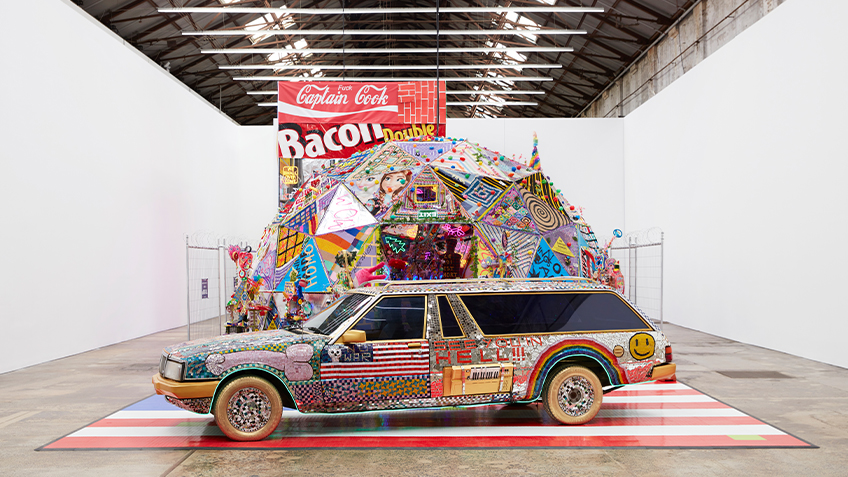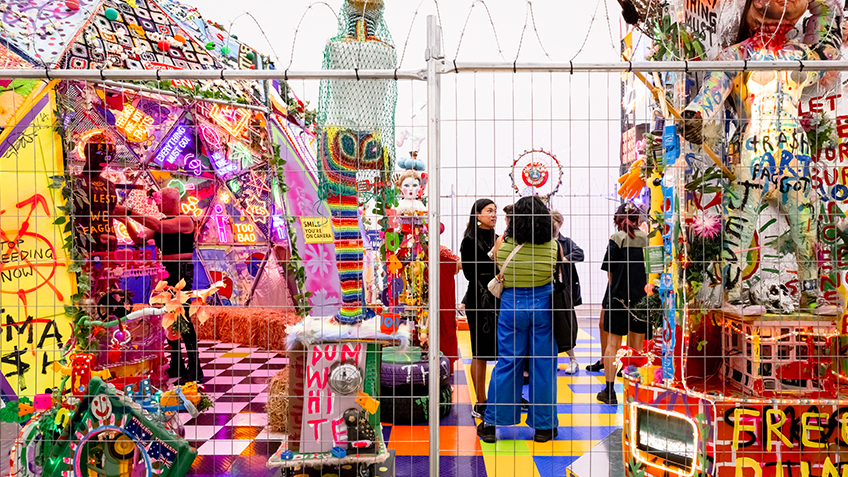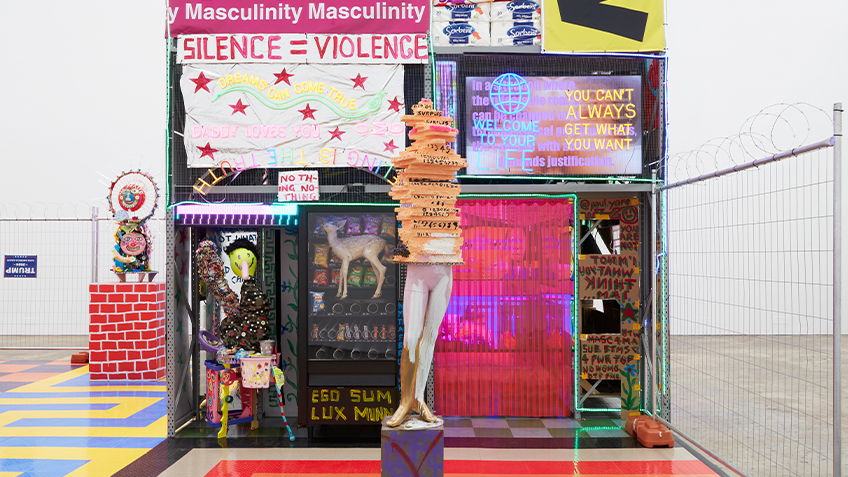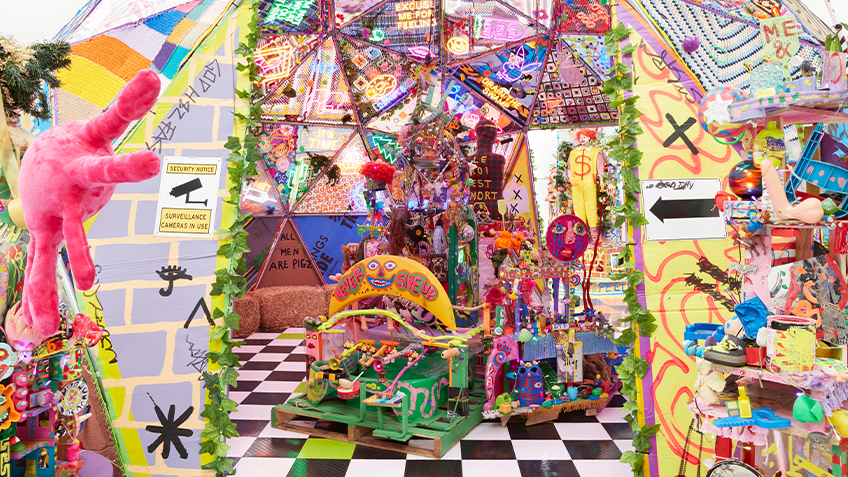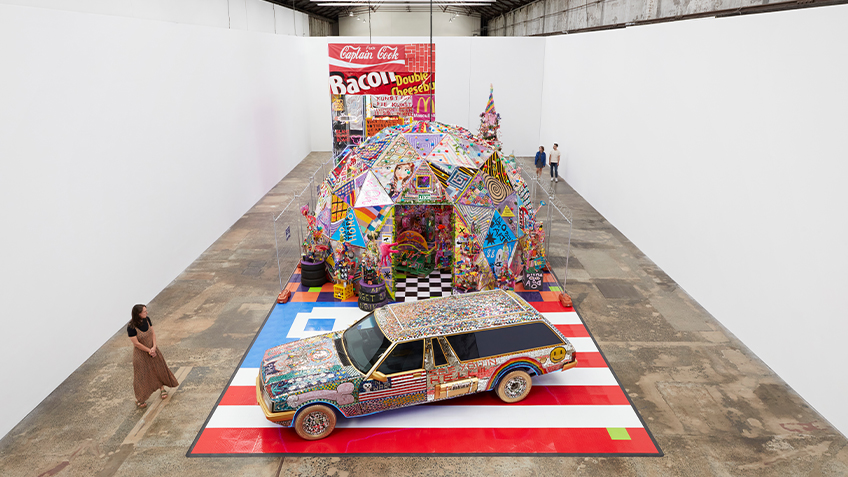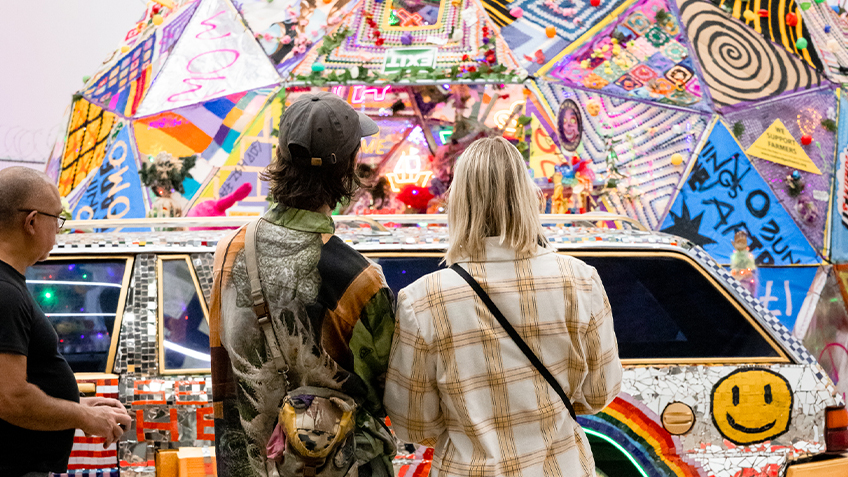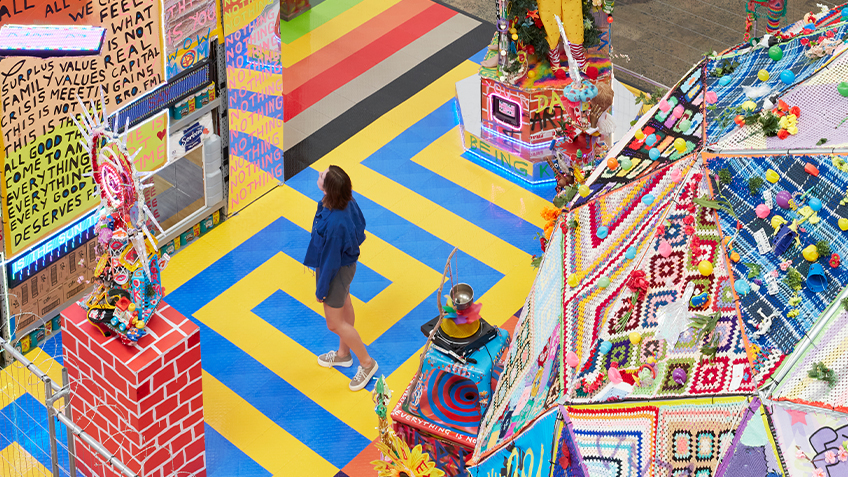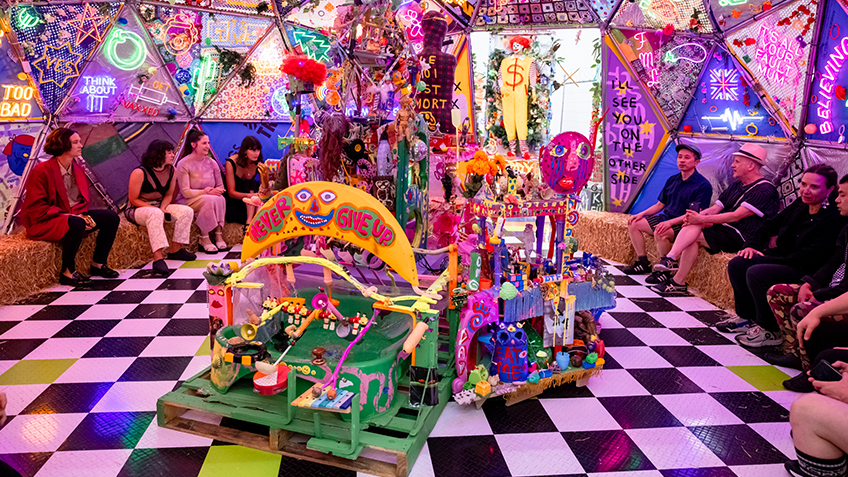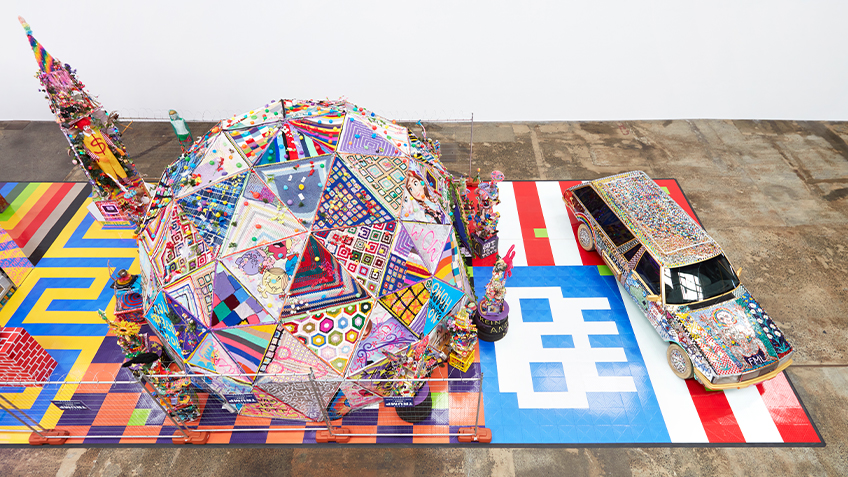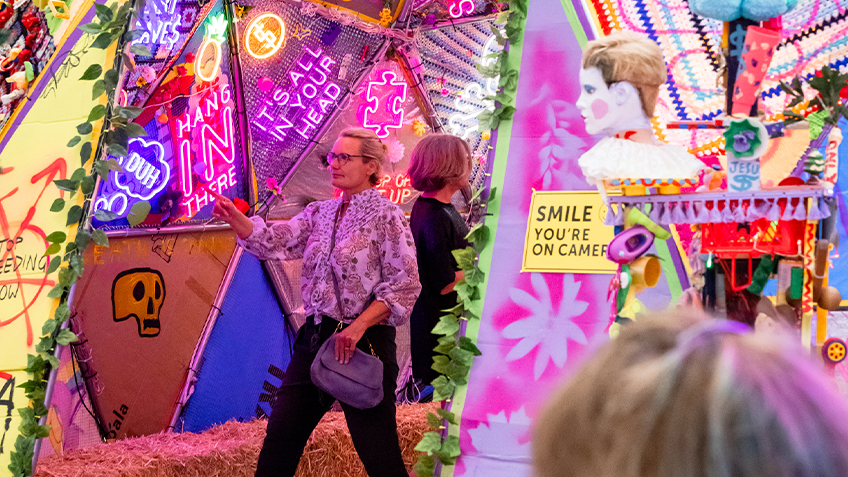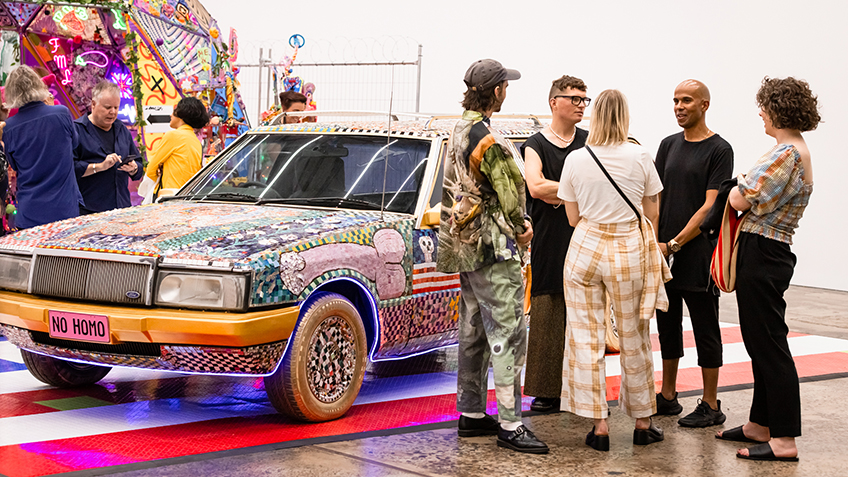The below interview between Max Delany (Artistic Director & CEO, ACCA) and Paul Yore was undertaken for the book Paul Yore: WORD MADE FLESH published by Art Ink in association with Australian Centre for Contemporary Art, 2023. Contact Art Ink for further publication details.
It might be helpful to start with a biographical sketch, with an outline of your upbringing, your parents’ involvement with missionary activity and the influence of Catholicism…
My mother Margaret grew up on a dairy farm on stolen Gunnaikurnai land in Gippsland. After college, she worked as a teacher and missionary in the Southern Highlands of Papua New Guinea where she met my father, Michael. He was a Franciscan friar from a humble coal-mining family in England. He lived and worked as a parish priest, preaching in remote villages for ten years before meeting my mother who happened to be teaching in the same region of PNG. They developed a close friendship which blossomed into a long-distance relationship, and eventually my father left the priesthood and moved to Australia to marry my mother. He became a social worker, and my mother a primary school music teacher. I grew up in the eastern suburbs of Naarm, the second of four children.
Following the example of the medieval mystic Francis of Assisi (c.1181 – 1226), Franciscan friars typically follow a life of poverty and contemplation. My father studied theology in the significant years following the reforms in the Catholic Church of the Second Vatican Council of the mid 1960s, and was particularly influenced by Liberation Theology, a doctrine that emerged from Latin America that sought to consolidate the radical message of the Gospels with Marxist philosophy. From my earliest years, I understood the compatibility of the mystical with the political, a position I take in my work to this day.
Catholicism formed an unrelenting presence in my childhood. I was a very serious child in some ways, and quite observant of the belief system that I had been folded into. I obediently served as an altar boy and choirboy and was attracted to the spectacle and ritual of Sunday mass, the hymns, the incense and candles, the regalia, stained-glass windows, and conjuring up of mysterious forces. But even from a young age I felt a deep confliction with Catholicism, one that eventually proved irreconcilable with my bourgeoning queer identity.
There is a strongly creative streak in your childhood interests (in art, musical instruments, dressing up, collecting, and Egyptology); whilst at school you experienced a growing self-awareness of being queer, along with the inevitable bullying, violence and othering that attended the policing of sexual difference. What was your experience of queerness in your younger years?
I was quite a gender-expansive and explorative child. In primary school I used to wear a dress and was also attracted to makeup. I loved wearing a grass skirt my mother had brought home from PNG, and I was something of a dandy, collecting stamps, coins, gemstones, marbles, feathers, shells, and other trinkets. I became fascinated with Egyptology after seeing the Rosetta Stone in the British Museum on a family holiday in 1997 and could write my name in hieroglyphs by age 12.
But my idyllic childhood came to an end in 2000 when I was sent to a private Catholic school for boys, which was hellish and prison-like. I was bullied mercilessly for several years, called a faggot, even though I was still in the closet, and physically assaulted. I felt alone, and at my lowest ebb experienced suicidal ideation. I did however find a small group of bookish outcasts, and we stuck it out together.
In 2001, when I was 13, I had my first full-blown crush on a boy in my class, and knew I was gay. Of course, I kept this to myself as I was already very unpopular at school. And the Catholic education system curriculum provided no insight into sexuality whatsoever beyond a very vague and mechanical discussion of heteronormative reproductivity. There was no mention of LGBTIQA+ identity at all. I was invisible.
You were born in 1987, and your year level were the first to have laptops in the classroom at high school, when you were twelve or thirteen. How important is the influence of the internet on your work and thinking?
As a millennial, I can only just remember the time before the widespread ubiquity of mobile phones and internet access, and I hit puberty right at a moment of accelerated growth in the presence of these technologies. When I was a child, there was still some of the sunny 90s optimism about internet culture, as a possible site of community, resistance, experimentation, and fluidity. As the decades have rolled on, it has become obvious that online space is a site for the intensification of the most insidious aspects of capitalist manipulation, government surveillance, and, most recently, a vector for dangerous far-right extremism. The dial-up internet of the early 2000s was very different to the cyberspace of today, and I spent my time online illegally downloading music on Napster and building a Myspace page with html code. It was also the age before the emergence of parental control filters and any concept of porn literacy. I was first exposed to hardcore pornography by another student, at the age of 12, and many times thereafter, mainly in the context of the classroom. As a kid, this was somewhat traumatic, as there was no contextual framework whatsoever to couch this graphic material. Later, as an adolescent, I found pornography more exciting, and the homosocial activity of viewing hardcore straight pornography with groups of other boys huddled around a laptop at school felt almost gay at times.
I experienced the harm of unmitigated technology firsthand. I consider myself a neo-Luddite and see my work in many ways as a reaction against the thoughtless mechanisation and digitisation of culture. Nonetheless, I am very interested in the way information is structured and experienced in online contexts, as a limitless bombardment, a kind of accumulation of undifferentiated and indiscriminate images, text, and data. As a form, the internet is a good image for our particular cultural moment: a sort of glowing labyrinth of half-truths and fabrications, a bottomless pit of misery and alienation. Formally, I draw on facets of internet culture in my work as a strategy for disarming audiences. In an age of low attention spans and boredom, the device of spectacle, of misdirection and subliminal messaging are key.
The early 2000s was also tumultuous politically, with the world witnessing the terrorist attacks of September 11, and the politics of fear which emerged as one of its enduring legacies. What do you recall of this seismic event, and the political culture post 9/11?
Of all my memories of my early teens, one of the most arresting is of watching the events of September 11 unfolding on television in 2001. I was thirteen, and it left an indelible mark on me. Coupled with my schoolyard torments, it led me to a view of the world as a hostile and troubled place. I suppose I began to form an identity as a reaction against what I observed around me which I viewed as violent, indifferent, deceitful and hypocritical. I often depict the events of 9/11 literally in the background of my work, as an attempt to describe how consequential this moment was culturally, and how the dust has never really settled culturally since those towers fell. The far-reaching repercussions in the aftermath of the so-called ‘war on terror’ has made the world less stable through escalations in both Islamist extremism and a newly emboldened American militarism and imperialism. The collateral of ensuing anti-terror legislation has resulted in a severe curtailing of civil-liberties and privacy of citizens globally.
These familial, social, cultural and political contexts laid a fertile groundwork for teenage protest, and the embrace of radical politics. What were some of the drivers which led to your immersion in activism and politics at this time?
In March of 2003, when I was 15, the US invaded Iraq, contravening international law. I remember watching the horrific ‘shock and awe’ assault on Baghdad. I became heavily involved in the anti-war protests, and I identify this period as one of the most formative of my teenage years. I organised students from my school to strike and join the protests and became adept at constructing and painting anti-war placards. I was immersed in, and embracing, the visual language of protest. I had become entirely fed up with the mediocrity of my peers and my family and began seeking out alternative philosophies. In retrospect, perhaps I was expressing my queerness through political rage. I was researching eco-anarchist philosophy online and was particularly captivated by the ideas of Norwegian philosopher Arne Næss, who coined the term Deep Ecology to refer to his blending of Spinozan metaphysics and the Ghandian ethics of non-violence. I was also attracted to the animal liberation movement, and began forming my own views on moral questions. I stopped eating meat, I stopped going to church with the family on a Sunday and volunteered for the Greens party.
As someone who works in a museum and gallery, I’m touched and heartened by your experience of excursions to public art galleries during your final years at school, by the impact of your encounter with the work of James Gleeson at National Gallery of Victoria, and other early art influences including Juan Davila, who you later met whilst a student at Monash.
Once I reached VCE, I was studying art and knew I wanted to be an artist. My year 11 class visited the NGV retrospective of James Gleeson, Beyond the Screen of Sight, in 2004, which had an enduring influence on me. I went back and saw it by myself four or five times. I was particularly taken by his small, collaged works on paper, featuring male nudes cut from old physique magazines interpolated into ambiguous landscapes rendered in watercolour. It was the first time I had seen ‘queer art’ in public space, and I found it immediately affirming. It helped influence my view that art could be anything – art, at its core, could be a fluid and emancipatory space. I had an enlightened art teacher who tried to organise an excursion to Bill Henson’s NGV retrospective. The school didn’t allow it, and so we ended up seeing NEW 05 at ACCA instead. I was also taken with Juan Davila’s NGV retrospective in 2006, a body of work within which excoriating attacks on settler colonialism and fascism shared the canvas with irreverent homoerotic themes and art historical references. As a mentor, Davila has had a lasting impact on my work, and influenced the manner with which I conduct myself as an artist.
Upon completing school, you travelled to India, Nepal and Tibet which you’ve described as an intoxicating immersion into the art and architecture of Hindu, Jain, Buddhist and Islamic traditions, but also a massive culture shock.
I left school frustrated, emotionally exhausted, and confused about my future. I worked in an office in the CBD for six months to save up enough money to travel with two friends in 2006. I was eighteen, had just come out as gay to my family and close friends, and was happy to be far away from Naarm. I was greatly influenced by the art and architecture of this part of the world, from early Buddhist sculpture to the palatial scale and decoration of the Mughal period. I was engrossed in the riotous colour and spectacle of everyday life in the mega-cities where the sacred and profane appeared to mingle freely. I saw things that struck me to my core: crushing poverty in vast slums, thick orange smog draped over cities, cows eating from giant piles of rubbish in the streets, road-side shrines comprising garishly coloured plastic figurines, ecstatic religious festivals and bodies being burnt on enormous funeral pyres. We visited mosques and a great number of temples, ashrams, and monasteries, trekked in the Himalayas, ate dahl, and smoked hash. I read Gandhi’s writings on self-sufficiency. I came home transformed, and a little less innocent.
After coming out, you became involved in the gay club scene, immersing yourself in house and techno music, party drugs, and experimentation. This must have been a formative period?
Perhaps I was overcompensating for so many closeted years at Catholic school! I had, for better or worse, quite an insatiable inclination towards intoxication, and so I was going out to gay clubs every weekend, usually by myself, meeting strangers, and staying out until dawn. For me, gay clubs were safe spaces of collectivity, where it felt as if there was an unspoken bond, a mutual understanding and camaraderie. I have always loved hard techno, trance, drum and bass, house, and garage music. With this kind of music, there is no need for words, just the throbbing beat of the music and ecstatic bodies moving as one. I also began experimenting with party drugs, psychedelics, anything I could get my hands on.
Many of these biographical trajectories and interests have been elaborated in the conceptual, material and methodological make up of your work. For example, you have noted the importance of mystic, visionary, psychedelic and shamanistic art practices as an important influence?
Issuing out of my experimentation with drugs, I became engrossed with psychedelic subculture, particularly that associated with the 1960s American countercultural context. I think what I was grasping at, but didn’t yet have the language to express, was that there is some vast ineffable energy that seems to linger just below the surface of everyday things, and that it is experienced emotionally, and can be registered in the practice of art.
In some ways then, I took the long path to contemporary art via psychedelic art and literature, naïve and folk art, vernacular architecture and visionary environments, and other examples of so-called outsider art. I was interested in irreverent approaches to everyday materials, and all-encompassing works of art that seemingly proceeded from a singular vision coupled with a healthy disregard for convention, practicality – perhaps rationality altogether. For example, I had researched the outsider artist Sabato ‘Simon’ Rodia and his remarkable Watts Towers construction long before I ever knew of Kurt Schwitter’s Merzbau.
You attended Monash University from 2007–2010, studying painting, alongside anthropology and archaeology, the latter disciplines proving instrumental in the formulation of your working methodology and iconoclastic visual language. Can you explain a little of how you came to work in the manner you do, collecting diverse cultural materials and assembling them into elaborate sculptural works?
I went through the art school system when it was still quite rigidly structured into specialist disciplines. Taking up painting as my major, I set about trying to capture something of my experiences with psychedelics in my work and made some dreadful paintings in the process! I eventually became frustrated with painting on canvas – the small scale, the rectangular flatness, and the muddiness of the colours, together with my complete lack of virtuosity. This reached an impasse in 2008 in the second-year painting studio when, one day, in very overdramatic fashion, I cut up all my paintings, and began using the wooden stretchers themselves to make a small, hut-like structure. It was bolstered with an easel, an old door and some other construction waste salvaged from a dumpster on campus. Over the next few weeks, I incorporated a great deal of found detritus into this make-shift structure, including empty beer bottles and energy-drink cans (the remnants of my cavalier lifestyle at the time), string, tin foil, cellophane, plastic flowers, toys, figurines, and a great manner of other op-shop trinkets and junk from the side of the road. Other students began bringing me plastic bags full of refuse which were in turn incorporated.
In many ways, the influence of anthropology, ancient history and archaeology was far more generative in terms of the direction of my work at that time than perhaps the lectures on 20th century art movements. I was stimulated by the theoretical underpinnings of archaeology and anthropology, which centred around epistemological questions, ideas of cultural relativism, and the constructed nature of societies – which I began to understand as unstable, linguistically-arbitrated conglomerations of knowledge systems, values and ideologies. I began to see my process of collecting and assembling objects as a kind of experimental archaeology, an investigation of the value systems embedded in the materiality of a cultural environment.
The work continued sprawling outwards, taking on a sort of camp performativity, and I began painting directly on the floor, as well as adding more and more layers of plasticine, human hair, glitter, and beads to the structure. It now resembled a crude grotto or shrine festooned with fairy lights and complete with a small trickling water-fountain. It absorbed everything in a virus like way, taking on a life of its own, and at times I felt like I was merely facilitating its growth.
At this time, I was working in an obsessive way; I was always the first one to arrive in the studio in the morning and the last one to leave, often working until late in the evening when the security guards would come around and lock up the university buildings at 9 or 10pm. It was also around this time that I met my partner, Devon. He was completing his masters research and we worked similar hours and started hanging out a lot. We would visit art exhibitions together, critique each other’s work, and he first introduced me to queer theory, in particular the foundational works of Michel Foucault and Judith Butler.
In 2009, whilst still an undergrad, you presented your break-out work The Big Rainbow Funhouse of Cosmic Brutality (Part II) at Heide Museum of Modern Art. How did this come about?
One day, some third-year students saw my rainbow-coloured hut in the studios at Monash and invited me to present a solo project at a now defunct artist run space called O Projects, in a room above a pub in Johnston Street, Fitzroy. This was my first exhibition, and I decided I wanted to build an expanded version of my structure and was confronted with a conceptual and logistical problem: how to translate this very unstable, accumulation of objects and forms into a coherent artwork for exhibition. What did it mean to re-present this work albeit in a different form? Was it the same work or a new work, or somehow both?
With this question unanswered, I undertook constructing The Big Rainbow Funhouse of Cosmic Brutality. The foundations were a simple cubbyhouse like structure, reinforced with tree branches, and clad with cardboard found in the alleyways of Fitzroy. The exterior of the form was decorated with a similar array of found objects and junk, strewn with fairy lights and plastic flowers. A little water fountain and a statue of the Virgin Mary stood near a small opening in the side of the structure, that the viewer could enter. Inside, the cardboard cladding was layered with tinfoil and mirrors, the shiny reflective surface, mimicking a chapel, in some way represented an interior or reflexive space, the space where the viewer literally saw themselves reflected back in the work.
It was my first experiment with the idea of immersing and implicating the viewer in the work. This idea was completed with a simple cardboard floor, which was painted with a spiral pattern. I was interested in positioning the viewer as participating in the work’s destruction, trampling on the painting underfoot. I also incorporated an experimental sound element into the work in the form of an old record player with a Ravi Shankar vinyl. I placed an upside-down bowl on top of the vinyl, so that the arm could never reach the middle and therefore the record could never finish. It was stuck in a feedback loop, sampling the same three or four seconds of music in a hypnotic cycle.
The late John Nixon, who was tutoring at Monash at the time, attended the exhibition, along with Sue Cramer, who was a curator at Heide at the time. The work reminded John of Mike Brown’s work, and Sue Cramer likened the work to an installation Mike Brown had made in the Heide II building in the early 1980s. Subsequently, Sue invited me to Heide to discuss the possibility of presenting a similar work in the project space at the museum. And so I got my first big break whilst still an undergrad.
Devon and I were visiting op-shops every weekend, collecting junk, old toys, statuettes, coloured blankets and other bric-a-brac and I began to think more critically about the work, the implications of its expansive materiality, and possibilities for critique that opened up in this intuitive and compulsive process of collecting and decorating.
Once the floor was in place, the structure was built using a simple pre-fab frame, reinforced with tree branches collected on site at Heide. Like the previous iteration, this structure was clad in cardboard. The outside was layered with coloured blankets, huge amounts of plastic refuse, toys, domestic objects like brushes and buckets, milk crates, bottle tops, seashells, cheap jewellery, figurines, and also incorporated a water fountain with red coloured water. The inside was similarly layered with tin foil and mirrors, and I constructed a mechanised sculpture from an old turntable, that span around hitting a series of bells, which gave the work an otherworldly air.
You experienced mental health issues in 2010, and have described a deeply traumatic time in hospital, which led to your taking up needlepoint, initially as a cathartic, therapeutic process, but which has become a critical modality in your practice, as a labour-intensive expression and embodiment of queer possibility.
In 2010, I had a mental breakdown, exhausted from juggling my double degree, a part time job washing dishes at a nursing home, and putting on a solo show at a museum. I was also still clubbing, binge drinking and using drugs habitually. All this culminated in a disastrous set of events in which I found myself sectioned, detained in a psychiatric facility against my will, whilst I was in England on holiday with my family. My experience at the hospital was deeply traumatising. I was held down and injected with sedatives and forced to take a cocktail of anti-psychotic medications which rendered me little more than a zombie. The whole incident caused a rift with my family and I felt completely alone, isolated and disempowered. After two weeks, I was able to appeal my sectioning, and released early from hospital. I stayed with my uncle and aunt in York while I recovered. It was around this time I bought some embroidery canvas and some coloured wool and a few needles and started slowly teaching myself needlepoint. At the time, I was still on heavy medication, which I was trying to slowly wean myself off. I was lacking in energy and sleeping most of the day and night, I felt completely numb. When I began using wool, I had not set out to make anything in particular, and certainly wasn’t thinking about art. I was just sitting on the couch at my uncle and aunt’s house slowly weaving this small canvas with wool. In needlepoint, you are essentially embroidering a canvas, filling up the plane stitch by stitch, building up an image slowly, pixel by pixel as it were. It is very slow and laborious, but I found it incredibly cathartic given the state I was in. I quickly became addicted to this activity, and found it was taking my mind off my situation. I kept working on the same piece for months and Devon and I eventually finished it upon returning back to Australia. The result was a work I called EVERYTHING IS FUCKED, the text borrowed from a song by the Australian band Dirty Three. The following year, I stopped drinking, smoking and drug-taking altogether, and I credit working in hand-sewn textiles almost daily as one of the key reasons I have managed to stay sober for over a decade.
Textiles, as Helen Hughes has noted in this publication, have historically been aligned with gendered labour; with feminist consciousness-raising and political struggle. Textiles have also been an important site of expression for LGBTIQA+ communities, from Leigh Bowery and David McDiarmid to the project of the AIDS Memorial Quilt. Why do you think textiles are so significant in a queer context?
I think textiles are first and foremost about self-sufficiency and community. Weaving is one of the most ancient artforms, doubtless predating painting, and has always involved the sharing of knowledge in a collective and lateral way, of storytelling and resilience building. Weaving, sewing and stitching are all associated with women’s work, and for me this is one great strength of textile forms: they historically sit outside the mainstream, and therefore have great disruptive potential.
Textiles are literally and figuratively absorbent, they take on the residues of life, the physical traces of the bodies that made or owned them. In this way they are powerful repositories of everyday life. And being highly tactile, both in the ways in which they are made and experienced, textiles critically engage touching and feeling – primal and intuitive ways of knowing that are prelinguistic and structured emotionally.
You have talked about quilting as an historical precursor to collage, involving the simple cut and relocation of an image, or slice of reality, alongside or within another image, to create an entirely new image or relationship. This most simple artistic technique is equally one of great complexity, subtlety and paradox. The cutting up of images is also inherently aggressive and iconoclastic, suggesting violence done to an image whilst also exposing the inherent violence of images.
I became interested in collage via the influence of beat generation writers such as William S. Burroughs and Allen Ginsberg. I was particularly inspired by Burroughs’ magnum opus Naked Lunch which he apparently wrote, and then literally cut up the manuscript and sticky taped it back together in a different order! It remains one of the most nightmarish books of the 20th century. I believe this cut up technique was in turn informed by an earlier generation of iconoclasts working in the shadow of fascism in Europe, the Dadaists in particular. I think the anarchist and agit prop approach of artists such as Hannah Hoch and John Hartfield retain much of their urgency and political relevancy a hundred years on which is both a testament to the courage of these artists but also the enduring legacy of collage and photomontage as methodologies of great primacy and disruptive power. I think ultimately this dynamic in collage issues from its instrumentalising of photographic material and its attendant claims to objectivity and ‘the real’.
Critically, these forms also ‘visualise the joins’, thus embodying the ways in which schemes of representation function more generally, as arbitrary and constructed. The tenuous and fragile nature of these seemingly random connections also implies the possibility of their undoing. I see this endless and circular process of unmaking and remaking as the preconditions for revolutionary activity, the erecting of something novel from the waste and ruination of the present.
You are no stranger to the real-world consequences of unmaking and remaking images, even in the hyperbolic and fictive setting of art. In 2013, you were commissioned to create a work for a group exhibition at Linden Gallery in St Kilda, titled Like Mike, curated as a homage to the avant-garde Australian artist Mike Brown. The resultant work, Everything is Fucked, was a large scale cacophonous installation encompassing literally thousands of found objects and images. Can you explain the controversy around this work, and subsequent legal charges?
Mike Brown pioneered installation art in Australia, and so my work was chosen to speak to this context. Brown was also charged with obscenity for an artwork he made in the late 1960s.
I set about developing an expanded version of the installation work I had made previously, it was essentially one single body of work, a colossal collection of objects and forms that had continued expanding during my studio residency at Gertrude Contemporary. The work had become much more abrasively and openly political by this time, partly owing to my experiences in the Occupy movement. I was incorporating political slogans, and Australiana. It had also become defiantly queer and libidinal; I was incorporating sex toys, phallic sculptures made of plaster and plasticine, nude figures from classical art, and collaged images from gay porn magazines, alongside the usual array of mass-produced remnants of consumer culture.
Devon and I spent a full week constructing the installation in the front room at Linden, which incorporated a huge amount of material. The internal space was quite chapel-like, with two figures standing like deities. The walls of the internal space were decorated with painted tinfoil and collages. It was the most ambitious and all-encompassing installation to date, including strobe lights and a small organ with half the keys pressed down with a clamp, that was hooked up to a censor, so when a viewer entered the space, they were met with a sonic wall of baroque discordance.
The show opened on the 18th of May 2013 and was well received. Ten days after the exhibition opened, on the 28th, there was a council meeting in St Kilda, at which a local Liberal party branch-member who had unsuccessfully run for council, and who hadn’t seen the exhibition, publicly raised the issue of what he deemed was offensive material displayed at the gallery, the gallery being funded by the local council. After the meeting, a member of the local community who had been at attendance at the council meeting, who had also been seeking to have the gallery defunded for years, visited the gallery. He then made an official complaint to the local police. After this single complaint, the gallery was visited by police officers who inspected the exhibition. The show became a powder keg waiting to explode.
Linden was subsequently issued with a search warrant and the gallery was raided on the 1st of June 2013. During the raid, the police cut seven images, using a Stanley knife, from the collaged interior space of the installation, thus decontextualising the images, and vandalising the work. It was front page news the next morning. Shamefully, after the raid, the gallery closed the exhibition without warning, further censoring the work, and denying the contextualisation of the work in the exhibition, and I was left in legal limbo, with no idea what would happen next.
On the 7th of September 2013, three months after the raid and one day before a federal election, I was finally formally charged with production and possession of child pornography, a crime carrying a maximum penalty of ten years in jail. The gravity of the situation suddenly felt enormous. The next day Tony Abbott was elected Prime Minister.
Twelve months after the charges were laid, the matter was finally heard in the Magistrates Court. I was exceedingly lucky to have prominent legal representatives, who took on my case pro bono. My legal team called upon a team of expert witnesses to attest to the artistic merit of the works in question, which formed a central part in our defence of the charges. Jason Smith, Antonia Syme and yourself all took the stand and were interrogated by a police prosecutor. We then had to wait about six weeks for the magistrate to reach her judgment. I sat with my legal team, with no idea what to expect, and listened to the magistrate as she handed down her decision. The charges were dismissed and I breathed deeply, it had been almost a year and a half since the saga began. The Magistrate rebuked the police for damaging my work, and they were also ordered to pay the costs for my legal team.
Beyond the legal scrutiny of your work, you have experienced censorship on multiple occasions, both internationally and domestically. In an Australian context, your work almost completely spans the socially divisive period of the so-called culture wars, initiated in the early years of the Howard government, and invigorated again under the Abbott-Turnbull-Morrison governments. Do you see your work as a reaction against this anaesthetising milieu of hyper-sensitivity and moralising?
In some respects, I would say my work reacts against both the outright idiocy of the right, and the self-protective judgment of liberal elites in institutional and academic circles. We have seen the fragility and hypocrisy of right-wing commentators laid bare, who decry the loss of their beloved freedom of speech supposedly amidst a tidal wave of woke cancel culture. Yet these same people bemoan almost any form of nonconforming cultural expression as political correctness. Meanwhile, the liberal elites preserve institutions of power by instrumentalising the cultural capital of marginalised subjects, but rarely actually implement far-reaching structural changes. It is a logical bind that has entirely toxified and suffocated meaningful critical discourse in this country. I have always pursued material, formal and conceptual strategies in my work that I see as a challenge to over-simplification of difficult questions, minimalism, institutional aesthetics, didactic or polite tokenism, perhaps good taste generally. Of course, some of these positions have resulted in misunderstandings and problematic outcomes for me and my work. But I have always accepted that not everyone will have a positive response to a work of art, and that creating debate is more valuable than just being liked.
The title of your survey WORD MADE FLESH, which is also the title for the new installation in the vast commissioning hall at ACCA, is drawn from the imagistic prologue to the Gospel of John in the Bible. What is it about this expression, so deeply rooted in the Christian tradition, that speaks to you as a contemporary artist today?
The Gospel of John stands alone in the New Testament as a richly intertextual blending of mystical Jewish thought and classical Greek ideas and, as such, is almost a collage in itself. I see the Bible as a very interesting historical and literary source, and just another found object in a way. There is much that can be read as radically queer in the Bible, that is often not discussed. For example, the centrality of the dually ecstatic and tortured body , or the idea of transmutability and potentiality in the world of matter, of forces beneath the surface of things, moving through time, places, people, and objects. Although the expression ‘word made flesh’ theologically refers directly to the incarnation (God becoming human in form through the person of Jesus), it is also a mystical and ambiguous grouping of words, catalysing a multiplicity of philosophically and poetically rich sources. For example, the idea of the logos refers to the mode by which the inward or hidden impulse of something is given concrete form or expression in materiality.
Your new work critiques but also reproduces the extremity of material-excess that proliferates in the context of Late Capitalism . In what ways can art challenge the prevailing modalities of production and propose alternative relationships between communities and the natural world in an age of increasing climatological instability?
In the years since I first engaged eco-anarchist ideas as a teen in the 2000s, an entirely new vernacular has emerged into the mainstream, that explicitly deals with the current ecological precarity. The notion of the Anthropocene has helpfully articulated the embeddedness of human activity in the natural world, to the extent that no neat boundary exists, with micro-pollutants and toxins flowing into the strata of soil and into the bloodstreams of organisms. Of course, the pandemic has also demonstrated the disruptive ways in which the ‘natural world’ flows back into human society as a direct consequence of human encroachment into and interference with the domain of the animal.
Art has the capacity to overturn accepted hierarchies, challenging the ‘rationalism’ that underpins the very systems that disregard human and non-human subjects. In this manner, I think there is great generative capacity for art to open up the types of disorderly and disruptive models of being that may in turn form building blocks for future societies.
You have long cited the rococo style as being particularly influential on your work. This eighteenth century art-movement and style was seen as a reaction against the classical grandeur and symmetry of the Baroque, and the strict regulations of church and state. Drawing from this highly elaborate decorative style, which involves humour, asymmetry, and the riotous play of language and codes, what function does adornment and embellishment play in your work?
Interestingly, the term rococo itself playfully comes from Vulgar Latin rocca meaning stone, via French rocaille, a term that refers to decorative shell or pebble work, of the variety popular in the aristocratic pleasure gardens, grottos, and follies of the eighteenth century. In my work, floridly tasteless ornamentation is primarily a conceptual strategy, but also a way for me as a maker to get lost in my own work. Primarily, decoration is a way of talking to a sense of decadence in our culture, a hedonism, and material excess that I see as signalling societal breakdown. Historically, cultural decadence seems to precede major events of civilisational collapse – just think of the final decades of the Roman empire, or indeed the demise of the tragicomic royal court at Versailles itself, that the rococo style embodies.
Decoration also relates to queer performativity, via drag culture, wherein the exaggerated use of sequins and rhinestones mimic and mock upper-class aspirations and gender norms. Collage, mosaics, junk assemblage and quilting all have a common strategic rationale, the assembling of a new, albeit illusory, whole from remnants or pieces of the ‘real’ world. In some ways I feel these forms, iterated through ceaseless embellishment, describe something of the surface and texture of forms under Late Capitalism: shimmering, illuminated, fragmentary. In this context, the creation of art is a way of dealing with the horror of the world, in a way that both mediates the traumatic impact, but at the same time refusing to conceal or repress the raw and brutal ‘truth’.
Paul Yore: WORD MADE FLESH
5 Jan – 26 Feb, 2023
Wed – Sun, 10am – 5pm
